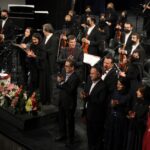
If the most significant event in the history of music censorship before the Iranian Revolution was Reza Shah’s infamous governmental decree banning the use of traditional Persian musical modes, then the second most pivotal event must be the post-revolution quality-control and censorship measures of the “Center for Revolutionary Songs and Music” under Iran’s Ministry of Culture and Islamic Guidance.
From the early days of the revolution up to the end of the Provisional Government, there was no serious discourse around banning certain genres, styles, or musicians.
However, over time, censorship became increasingly severe. The first targets were female vocalists, and eventually, this wave of suppression extended to nearly all forms of music that fell outside the framework of revolutionary or epic themes.
During this period, some musicians attempted to preserve music through negotiation with cultural authorities. The Tehran Symphony Orchestra, on the brink of collapse, was among those saved through such efforts. Meanwhile, a group of musicians sought to protect a broader range of musical expression by identifying and highlighting musical elements perceived by authorities to be more compatible with religious or ideological expectations.
A documented directive, signed by several musicians, prohibited the use of compound 6-beat meters—deemed by the general public as being too close to “light music.”
(Excerpt from Mehr Weekly, October 5, 1999)
Instruments like the tonbak and the violin (in its Persian style) were also temporarily sidelined. At one point, tonbak lessons—once mandatory at the music conservatory—had to be taught secretly in the conservatory’s kitchen.
Yet even more damaging than these restrictions was the rise of an extreme and—according to the author—historically and scientifically flawed ideology that found its way into the heart of the music censorship apparatus.
This ideology can be traced back to the late 1940s, when a group of French musicologists, with little understanding of Persian music and under the influence of postcolonial discourse, gave a series of lectures in Iran that gained traction among certain local intellectuals.
These scholars classified Persian dastgāh music as a form of folk music. As a result, they either denied the need for its evolution altogether or advocated for only the most conservative forms of change.
Over time, the term “Persian classical music” (used in early 20th-century writings to describe a sophisticated, creative, and evolving art form) was gradually replaced with the more misleading label “traditional music”—a term loaded with assumptions about authenticity and resistance to change. Thus, any evolution came to be labeled as “distortion” or “corruption” by proponents of this worldview.
It was as if dastgāh music had been frozen in time—as a “pseudo-art” incapable of innovation, where any modification was seen as a threat to its purity. Unfortunately, this perspective was internalized by parts of the censorship system and cast a shadow over some masterpieces of Persian classical music. While resistance from musicians prevented these works from being entirely suppressed, many were still released under labels hinting at “corruption” or “deviation.”
Thankfully, the press rarely echoed these terms. Most critics at the time, when reviewing albums, didn’t even bother to explain the abbreviated censorship labels issued by the Ministry of Culture. One such example, a page from Mehr Weekly, includes the ministry’s categorization and rating of an album—yet the critic entirely ignored these ratings and focused instead on a substantive review.
With the rise of digital platforms and the widespread use of social media, requests for music licenses from the Ministry have significantly declined. Nowadays, licensing is mostly sought for official concert performances.
Fortunately, this distorted view of Iranian music never managed to fundamentally derail its artistic evolution. Even the involvement of those with such views in prestigious music academies failed to mainstream the ideology. Today, what remains of that movement is merely the bitter memory of a group that, despite their claimed good intentions, became allies of censorship.
(Etemad Newspaper, February 3, 2025)








